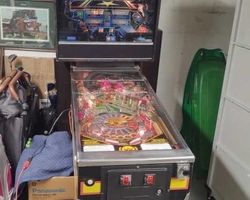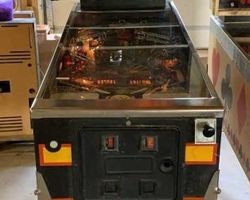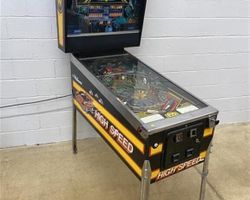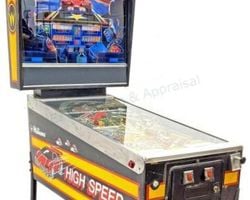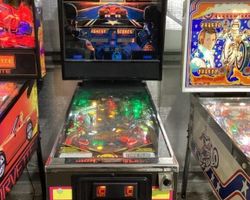High Speed
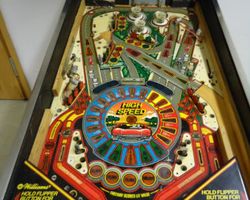
Average Prices: USD $400 to $1,700
Produced: January, 1986
Production Run: 17,080 units
Machine Type: Solid State Electronic
MPU: Williams System 11
Players: 4
Concept by: Steve Ritchie
Design by: Steve Ritchie
Art by: Python Anghelo, Mark Sprenger
Music by: Steve Ritchie, Bill Parod
Sound by: Larry DeMar, Eugene Jarvis, Bill Parod
Software by: Larry DeMar
The "High Speed" pinball machine, manufactured by Williams Electronic Games, Inc., is a landmark in the evolution of pinball games. Released on January 2, 1986, this machine was a revolutionary design by Steve Ritchie, featuring a captivating police chase theme inspired by a real-life high-speed police pursuit involving Ritchie himself in his Porsche 928. This theme, coupled with elements of cars and crime, set a new precedent in pinball narrative immersion. With contributions from artists Mark Sprenger and Python Anghelo, and sound production by Larry DeMar, among others, "High Speed" marked significant milestones by being the first pinball machine to feature a complete musical score and alphanumeric displays, shaping the future of pinball design and development.
Signature Features and Design
"High Speed" boasts several standout features that have captured the attention of players for decades. The iconic traffic light mechanism is central to the game, facilitating a dynamic progression system where players must "run" a red light to initiate a thrilling chase sequence. The game also includes a rotating police beacon light and a functional rearview mirror that reinforces the theme, while details like Sprenger's hidden four-leaf clover bring a touch of whimsy to the artwork. This intricate design not only enhances the visual appeal but significantly elevates the gaming experience, offering a cohesive blend of narrative and interactivity.
Playfield and Mechanics
The playfield of "High Speed" is a testament to Steve Ritchie's design philosophy of fast-paced flow and engaging player interaction. The layout features three primary flippers, three pop bumpers, and a single ramp essential for progressing through the game. Interactive toys such as spinning targets and slingshots invite continuous action, while strategic elements like the left outlane kickback provide players with a safety net against ending their game too soon. The artwork, characterized by vibrant colors and thematic elements like police insignia, complements the kinetic flow, while the playfield’s lighting intensifies during high-stakes moments like multiball to enhance player immersion.
Gameplay Dynamics
The gameplay mechanics of "High Speed" are meticulously designed to deliver an adrenaline-pumping experience. Players advance through the game by hitting targets that impact the traffic light's status, with the ultimate goal of triggering a police chase. This chase sequence challenges players to reach the escape point by shooting the ramp at the right moment, followed by unlocking the multiball feature. Points are accrued through a clever combination of ramp shots, target completion, and bumper hits, all supplemented by bonuses that accumulate during play. Experienced players often emphasize ramp mastery and strategic multiball activation as key strategies for achieving high scores and maximizing the game's scoring potential.
Reception and Legacy
"High Speed" received widespread acclaim from both players and critics, praised for its innovative gameplay mechanics and immersive theme. Its combination of accessibility and challenge allowed it to appeal to novices while keeping veteran players engaged. Despite minor critiques regarding repetitive elements, its legacy endures as it redefined pinball in the 1980s, influencing subsequent machines with its advanced technological implementations such as Auto Percentaging. Today, it holds a revered place in the pinball community, celebrated for its timeless appeal and regarded as an essential piece of pinball history.
 Active Auctions
Active Auctions
 Auction Results
Auction Results
| Cost | Location | Date |
|---|---|---|
| EUR €2,500 |  Nordrhein-Westfalen, Germany Nordrhein-Westfalen, Germany |
03 November, 2024 |
| USD $2,750 |  Nebraska, United States Nebraska, United States |
20 October, 2024 |
| USD $1,850 |  Georgia, United States Georgia, United States |
07 October, 2024 |
| USD $2,800 |  Oklahoma, United States Oklahoma, United States |
07 August, 2024 |
| GBP £2,200 |  London, United Kingdom London, United Kingdom |
06 August, 2024 |
| USD $4,000 |  Florida, United States Florida, United States |
24 July, 2024 |
| USD $4,250 |  Georgia, United States Georgia, United States |
10 June, 2024 |
| USD $3,999 |  Iowa, United States Iowa, United States |
18 April, 2024 |
| USD $2,500 |  California, United States California, United States |
10 March, 2024 |
| AUD $4,600 |  New South Wales, Australia New South Wales, Australia |
17 February, 2024 |


Private Policy · Search Website · Contact Us
All trademarks and copyrighted materials remain property of their respective owners.
All other content copyright 2007 - 2025 Pinpedia.

